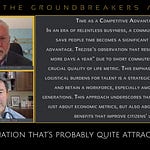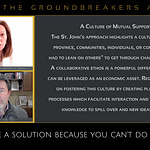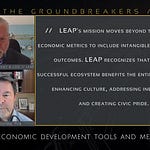Global competition isn’t easy. Sometimes it takes radical change, bold declarations of intent, and systematic, intentional implementation. That message comes shining through in my discussion with Malcolm Bruce, Edmonton Global’s outgoing CEO.
The idea of shifting perceptions and changing the way business is done animated much of our conversation. Done successfully, these are the shifts that lead to billions in new investment and the emergence of entirely new industries.
“The purpose of Edmonton Global is to radically transform and grow the economy of the Edmonton Region.” How the 14 regional partners manage this, from life sciences to global logistics, makes for a very interesting watch.

From the Video. LINK Analysis: Edmonton, Alberta
+Growth: Regional collaboration fosters an ‘addictive ecosystem’ by integrating shared infrastructure, talent, and knowledge. This creates a powerful network effect where each new investment or business success attracts others building a self-sustaining cycle of innovation.
Leveraging Uniqueness: Edmonton’s example highlights a core tenet of regional differentiation: local characteristics are not a limitation but a catalyst for growth and diversification. By building on its underappreciated geographical advantage,
Edmonton is creating new economic opportunities that are both authentic to its identity and globally competitive.
Beyond Municipal Borders: A pan-municipal approach to economic development creates a regional value proposition that is far greater than the sum of its individual parts. By pooling diverse assets—talent, infrastructure, and industry—a region can achieve the ‘mass’ and ‘innovation’ sought by international investors.
Ecosystem Synergies: International investors don’t care about municipal boundaries; they care about a complete value proposition.Edmonton’s regional approach shows that an innovation ecosystem’s strength lies in its ability to connect disparate assets—from talent in the city to heavy industry outside. This strategic integration fuels an ‘interconnected growth’ cycle where success in one area, like research, fuels growth in others, like industry.
Crisis as a Catalyst: The COVID-19 pandemic served as a strategic leapfrog opportunity for Edmonton. By identifying a national supply chain gap, the region was able to combine its research and manufacturing assets into a ‘high-impact initiative’ that elevated its economic complexity and created a new, vital industry.
Integrated Strategy in Action: Edmonton’s life sciences initiative is a textbook case of a successful integrated economic development strategy. It showcases a multi-stakeholder partnership—involving provincial government, federal government, and the private sector—that mobilizes a region’s core competencies to solve a pressing national problem, demonstrating a shared vision and coordinated action.
Affordability as a Differentiator: Edmonton’s ability to maintain housing affordability by meeting population growth with new construction positions it as a ‘sticky’ ecosystem. This focus on a high quality of life—a key differentiator—makes the region a desirable place for talented workers and entrepreneurs, boosting the innovation ecosystem.
Closing the Talent-Innovation Loop: The Edmonton region shows that a strong talent pipeline starts with high-quality educational institutions and is completed by an affordable, vibrant community that encourages graduates to stay. This virtuous cycle ensures that local knowledge creation and transfer translates directly into economic output and progress for the region.








